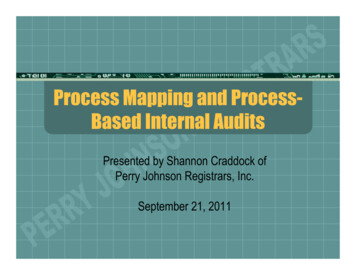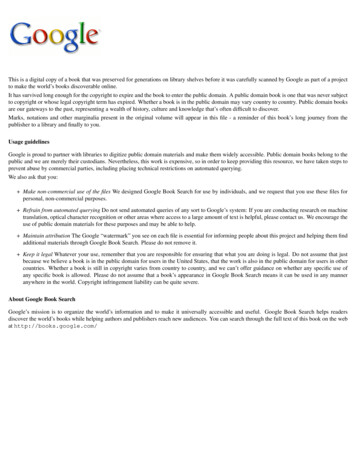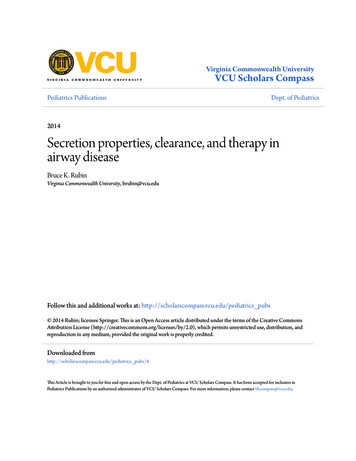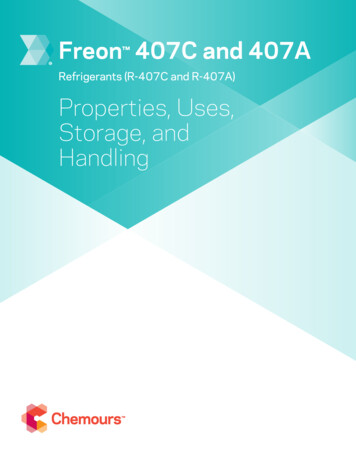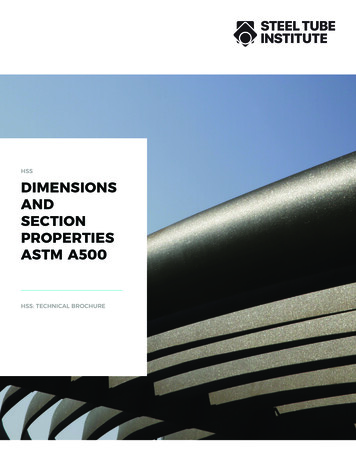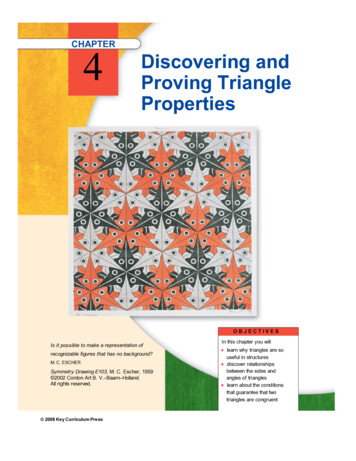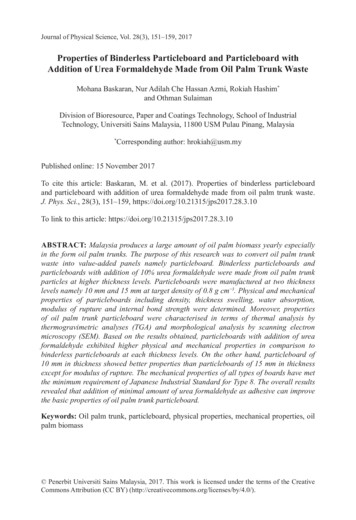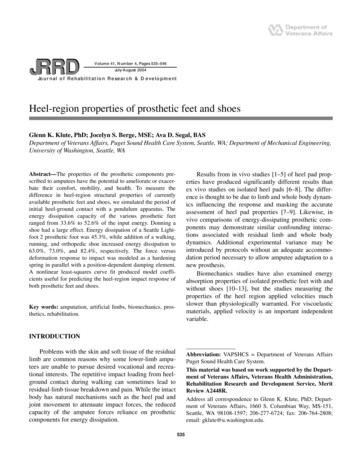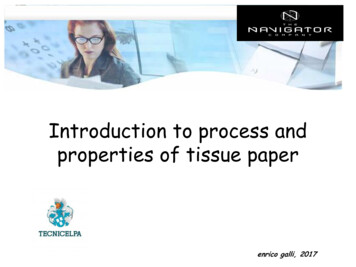
Transcription
Introduction to process andproperties of tissue paperenrico galli, 2017
Enrico Galli self-presentation I was born in Viareggio (Lucca county or “the so called tissue valley”) Tuscany - ItalyGraduated in Chemical Engineering at University of Pisa in 1979 Process and project engineer and then technical manager in oil industry (oil refineries and spent lube oil re-refining)in GULF, API, AGIP in ItalyTechnical manager in chemical and consumer products company (soap, detergents, derivate from fatty acids,sanitary gloves, tissue paper) in Italy. Since 1984 in paper and tissue business: Italy: Tissue (PM, PBD, CON), Newspaper (PM), Cardboard paper (PM, MM) Estónia: Tissue (PM, CEO) France: Tissue (PM) Hungary: Tissue (CON) Nigéria: Tissue (CON) Romania: Tissue (PM, PBM, MM, CON), Writing paper (PBM) Rússia: Tissue (PM) Spain: Tissue (PBM) UK: Tissue (PBM) Cooperation with following main European Tissue Companies: Annunziata (now WEPA – Italy), GP (now Lucart –Italy), Horizon Tissue (Estonia), Imbalpaper (now Sofidel – Italy), Kartogroup (now WEPA – Italy, France, Spain),Montebianco (Romania), Pehartec (Romania), Perini (now Sofidel – Romania, UK), Siktyvkar Tissue Group (Russia),Vaida Papir (Hungary) and now proudly NAVIGATOR in Portugal! I have been supporting Sales and Marketing Teams for strategic planning as well as for products development inBaltic Countries, BENELUX, Denmark, Finland, France, Germany, Hungary, Ireland, Italy, Norway, Poland, Romania,Russia, Spain, Sweden, UK. Since 1998 I have been teaching “Paper plants and tissue production and converting” at the University of Pisa (Italy).Since 2015 I have been giving aula about Tissue Technology at the University of Coimbra (Portugal)enrico galli, 2017
“tissue”: what, where, howenrico galli, 2017
What is “tissue”?In paper business the world “tissue” includes all paper products used forhygienic and sanitary purposes both at home (“consumer” or At Home – AtH– products) and/or in public places (“catering” or HOtel REstaurants andCAfé – HORECA – or Away From Home – AFH – products): “tissue” istherefore toilet paper and kitchen towels but also handkerchiefs, napkins,industrial rolls, facial tissues, medical sheets, etcetera).enrico galli, 2017
What’s inside the “pack”?We can assume that inside a toilet paper pack we should find some toilet paper rolls, butthe different market actors’ selling strategies as well as the different consumers’ attitudesand needs require different tissue products quality and packaging: Entry level or “first price” products: these products match only the basic requiredperformances, they are very often low quality raw materials based and sold inminimalist packaging (standard packs with few color images). They are present in harddiscounts while in supermarkets they are identified as “first or best price”; the sameones can be found on hawker benches, local markets, suburban bazaars. Brand products: branded products lines by big local and multinational companies and in this case - present on different national markets. These lines are internally developedand very often supported by dedicated advertising campaigns. The best techniquesboth for paper production and converting/packaging available in each company areused to design products with some gaps Vs. other ones in the market. These productsare “necessary” present in most selling points due to consumers’ request. “private label”: products sold using the (sometime more than one for quality and pricedifferentiation) retailer brand and produced by third companies. Big retailer chains arerequiring higher and higher products quality comparable with the best ones in themarket to use the consumer loyalty to the retailer brand and a lower selling price ascompetition advantages Vs. branded products.enrico galli, 2017
O mercado mondial do papeltissueenrico galli, 2017
World consumption distributionTotal world - year 20131%2%6%26%North AmericaWestern Europe19%Eastern EuropeLatin AmericaNear & Middle EastJapanChinaAsia Far EastOceania6%Africa4%20%11%5%Total consumption: 32,5 MMtons (year 2013)that represents about 50 billionsource: RISI, 2014
Western Europe tissueconsumption by main countryMain markets:Germany, UK,France andItalyPeninsulaIberica (Spain &Portugal)market size isabout the sameas Italy orFrancesource: RISI, 2015
Consumer productscharacterization and testingenrico galli, 2017
The consumer tissue productsWe can include in consumer category all the tissue productssold to the final consumer for at home (and personal) use: Rolls Toilet paper Kitchen rolls (towels) Special wipers Folded products: Napkins Towels in sheets Handkerchiefs Facial box tissues Wet and moistured tissuesenrico galli, 2017
Toilet paperToilet paper rolls are identified through following characteristics: Base paper: quality: virgin pulp, de-inked pulp, mixed basis weight: normally from 15 to 17 g/m2 White or colored Roll (elementary unit) Number of plies: normally 2, 3 and 4 (but also 5 in some markets) Ply bonding: Lamination: plies are glued together (only for embossedproducts) Mechanically: edge embossing Embossing type and pattern: the surface sculpture of the paper Decoration: Colored glue Printing Others: perfume, balsam, etcetera Roll height: normally from 90 to 100 mmenrico galli, 2017
Toilet paper (continued) Roll diameter: normally from 100 and 120 mm as a function of theroll paper length and embossing type Number of services/sheets Service length: normally from 122 and 138 mm Core diameter: normally from 38 to 50 mm Pack (Consumer Unit): Type: horizontal or vertical Number of rolls per pack Packing material: normally multicolor printed PE or PP Others: handle, easy opening, squeezed rolls Bundle (Selling/Commercial Unit) Number of packs per bundle Bundling material: normally plain PE Pallet (Logistic Unit) Type of pallet: normally EURO (80x120 cm) Display pallet: packs without bundle are directly displayed on thepallet for direct picking by consumerenrico galli, 2017
Toilet paper: consumers’ expectationsMost important technical characteristics and performances required for consumer toilet paper arethe following: Softness: sensorial characteristic resulting from bulk ( thickness), surface smoothness ( handfeel) and reduced rigidity (sometimes called “clothness” to indicated that the paper lookslike a “rag”); Bulk and smoothness can be measured both on base paper and finished product, but theonly reliable way to evaluate the finished product softness is a “comparative panel test”; Dry strength: Represents an indication of the product adequacy to its primary use; It can be measured (MD and CD) both on base paper and finished product andpractical/standard values exist; Wet strength: Is related to the capacity of the product to be easily dissolved to avoid any toilet blockageproblem; It can be evaluated both on base paper and finished product as max ( 10%) acceptablepercentage of the dry strength and/or the finished product “solubility” and flush-abilitycan be directly tested; Perforation efficacy: Perforation must be strong enough to get the request number of sheets, but not toostrong provoking the longitudinal crashing of the sheets; It can be evaluated on finished product as ratio Vs. dry [MD and CD] strength.enrico galli, 2017
Kitchen rollsKitchen rolls are identified through following characteristics: Base paper: quality: virgin pulp, de-inked pulp, mixed basis weight: normally from 18 to 22g/m2 White or colored Roll (elementary unit) Number of plies: normally 2 (but also 3 in some markets) Ply bonding: Lamination: plies are glued together (only for embossedproducts) Mechanically: edge embossing (rare) Embossing type and pattern: the surface sculpture of the paper Decoration: Colored glue Printing Roll height: normally from 225 to 260 mm (rare)enrico galli, 2017
Kitchen rolls (continued) Roll diameter: normally from 100 and 120 mm as a function of the rollpaper length and embossing type; actually “big” jumbo kitchen rolls upto 160 mm diameter are distributed in the consumer market Number of services/sheets Service length: normally from 210 and 240 mm Core diameter: normally from 38 to 50 mm Horizontal pack (Consumer Unit): Number of rolls per pack Packing material: normally multicolor printed PE or PP Others: handle, easy opening Bundle (Selling/Commercial Unit) Number of packs per bundle Bundling material: normally plain PE Pallet (Logistic Unit) Type of pallet: normally EURO (80x120 cm) Display pallet: packs without bundle are directly displayed on thepallet for direct picking by consumerenrico galli, 2017
Kitchen rolls: consumers’ expectationsMost important technical characteristics and performances required for consumer kitchen rolls are: Absorbency: Total (or practical) absorbency: Represent the quantity [of water] that the paper absorb (and keep!) per unit of mass(weight); It can be measured both on base paper and finished product and practical/standardvalues exist; Absorption speed: Represent the paper performances as “fast drinker” It can be measured on base paper and practical/standard values for the base paperexist; Finished product absorption performance: Represent the “real” performance of one sheet of finished product in terms ofabsorbency and absorption speed; It can be measured on finished product and practical/standard values exist onmarkets; Dry and wet strength: Represent an indication of the product adequacy to its primary use; They can be measured (MD and CD) both on base paper and finished product andpractical/standard values exist on markets; Perforation efficacy: Perforation must be strong enough to get the request number of sheets, but not toostrong provoking the longitudinal crashing of the sheets; It can be evaluated as ratio Vs. dry [MD and CD] strength of the finished product.enrico galli, 2017
NapkinsNapkins are identified through following characteristics: Base paper: quality: virgin pulp, de-inked pulp, mixed basis weight: normally from 17 to 22 g/m2 White or colored Napkin (elementary unit) Number of plies: normally 1, 2 and 3 Ply bonding: Lamination: plies are glued together (only for 2 and 3 ply fullembossed napkins) Mechanically: square embossing (only for 2 and 3 ply notembossed napkins) Embossing type and pattern: the surface sculpture of the paper All over embossing (only for 1 ply napkins) Micro point-to-point embossing (for 2 and 3 ply napkins) Square embossing (for 2 and 3 ply napkins)enrico galli, 2017
Napkins (continued) Decoration: Colored glue (rare) Printing Dimension: normally 24x24 cm, 30x30 cm, 33x33 cm, 38x38 cm,40x40 cm Folding: normally ¼, but also 1/8 Horizontal pack (Consumer Unit): Number of napkins per pack Single (1 stack) or double (2 stacks) Packing material: normally multicolor printed PE or PP Others: easy opening Bundle (Selling/Commercial Unit) Number of packs per bundle Bundling: normally cardboard box Pallet (logistic unit) Type of pallet: normally EURO (80x120 cm) or demi-pallet (80x60cm) but also quarter pallet (40x60 cm) for display boxesenrico galli, 2017
Finished products (rolls) testing Elementary unit visual and dimensional analysis: roll diameter and height, sheetsnumber and dimension, roll paper length (calculated), core diameter, roll weight, coreweight, paper weight (calculated), number of ply, ply bonding system, embossingpattern description Softness: surface smoothness, panel test Physical tests: Basis weight and single ply basis weight (calculated) Tensile: MDdry and CDdry MDwet and CDwet Ratios (calculated) MDdry/CDdry, MDwet/CDwet, MDwet/MDdry, CDwet/CDdry,(MDdry CDdry)/2, (MDwet CDwet)/2 Thickness and bulk (calculated) “Solubility” and/or flushability Absorption capacity: practical absorption, absorption speed, absorbencyperformance test Brightness (when applicable) Color and color stability (when applicable) Ash content (only for DIP or mixed paper based products)N.B. in red only for toilet paper – in blue only for kitchen rollsenrico galli, 2017
Tissue paper production and[rolls] convertingenrico galli, 2017
Rolls production and product qualityAux RM (chemicals,glues)RM hedproductsDry strengthperforationDry/wet strengthperforationenrico galli, 2017KitchenabsorbencyToilet papersoftness
The Paper MillPaper Mill – Fabrica de papelstock cleaning –limpeza massapulp - celulosestock cleaning –limpeza massastockpreparation –preparacaoTissueMachine –maquina depapel tissueslitter combiner– rebobinadorwaste paper –papel recicladoenrico galli, 2017
The Paper production processStock Preparationpulperstockapproachcleaningsystem &&fan pumprefiningPulp bales are pulpered –Stock is cleaned andrefined (SW & HW) and/ordeflaked (HW) and then(approach system and fanpump) the fan pump fed tothe Tissue MachineTissue Machineheadboxpresscreepingsectionformation Yankee §ionhoodpopereelHeadbox “distributes” thestock on the full width ofthe forming section –Water is eliminated troughdewatering, mechanicalpressing, evaporation –Creeping doctor tear outthe paper web from theYankee to the Pope Reelslitter rewinder Parent rolls produced atTM Pope Reel are [ifnecessary] calendered,combined and slitted tothe required formats andrewind in JRenrico galli, 2017
Tissue paper production: StockPreparation (SP)enrico galli, 2017
Virgin Pulp Stock PreparationHardwood LineStock Preparationpulperstockapproachcleaningsystem &&fan pumprefining ConvertedBroketo approach 4,5 %Dump ChestHD-CleanerHW Refiner (TwinFlo,conical, cylindrical)Softwood Line 4,5 %PulperFeedingLow-highconsistencypulperDump Chest HD-Cleanerto broke chestto approachSW refiners(TwinFlo)courtesy of VOITH, 2014
Approach flow and broke systemfrom
The paper web passes through an opening roll 1 (wrinkles smoothing) and a driving group 2 to the edge embossing unit (if required) and then to the perforator 3. In the

